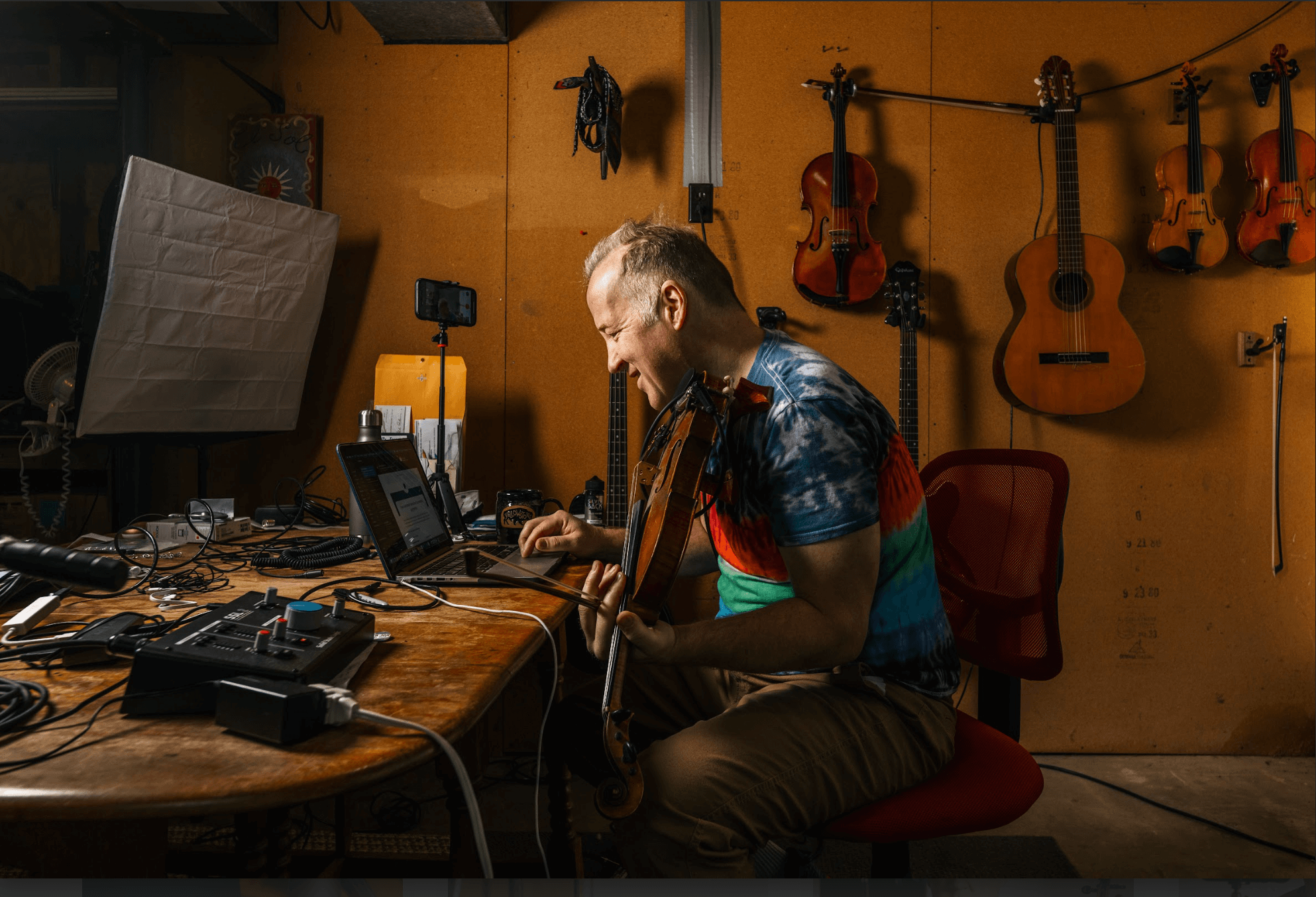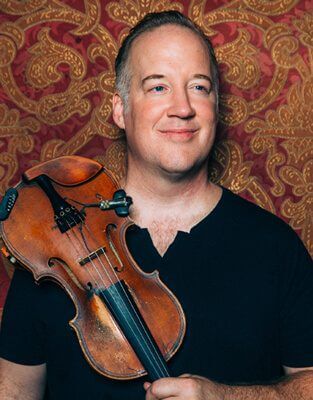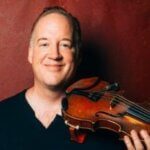Table of Contents
In this post, I'll break down how you can streamline your practice while gaining missing musical skills to become a more versatile, creative, confident musician.
Who this is for: players and teachers interested in having a more functional, sustainable way of making (or teaching) music.
I cover this curriculum during my 7-week Zoom guided practice sessions Creative Strings Workshop Online twice per year (in Winter and Summer).
Even if you don’t join, reading the curriculum below can clarify your direction.
Module 1:
Easy Tonal Improvisation
How to visualize & apply harmony on your instrument so you can:
- improvise melodies,
harmonize melodies,
accompany others in duo, trio, quartet with or without a bassist - make your own loops, acapellas, or covers
- Arrange unaccompanied performances of songs to perform alone without sounding boring
The inability to hear, see, or apply harmony on a bowed string instrument is one of the most common problems, regardless if you were trained classically or in fiddle or other styles.
3 reasons why:
- Bowed string instruments are not laid out like in a grid like piano, making harmony more difficult to visualize.
- They don’t have frets like a guitar, which makes it hard to learn and apply simple chord shapes across 12 keys
- They use a BOW
Like most string players, I struggled to apply harmony on the violin fingerboard.
I discovered that visualizing it on paper could speed up the process, like training wheels on a bike. I developed a visual aid for this, like a diagram.
The diagram shows all the points of connection in the chord progressions. By reading along with it, and applying a few exercises, you’ll never look at harmony the same way again.
The truest way to understand harmony is to “see” the voice leading, i.e. know the relationships between chord tones in any chord progression.
Module 2:
Free Improvisation
AKA 100 ways to play whatever you want, when you want to, and develop creative language,
regardless of your current technical facility, theory, or stylistic language.
This is important for:
- getting out of ruts
- not playing the same ideas all the time,
in solo, small ensemble, or conducted large ensembles - playing over songs
Because it doesn’t help to understand harmony if you can’t apply creativity.
When you invest in building your language or sound, tension can arise around not wanting to sound “bad”.
There’s a difference between playing something unfamiliar vs bad. Fear of sounding bad pushes us to stay in the realm of the familiar.
Exploring your creative voice makes space to grow past artificial constructs and into your true full expression.
Other ways free improvisation is helpful:
- You can integrate with technical maintenance so it doesn’t require adding practice time
- You don’t need to know theory. A 3 yr-old can do free improvisation. (In week 2 of Creative Strings Workshop you will do many free improvisations)
- It can be a conduit for mindfulness
Free improvisation doesn’t need to be angular or 12-tone. It can be pretty, spacious, or whatever you want. You get to make it align with your voice, and your values.
Module 3:
Mindful Integrated Creative Practice
I get it. You’ve read books, got a degree, taken lessons, and still feel your musicianship is not where you want it to be.
- You have a stack of things to practice and a million things to feel you need to get better at, and you throw a lot of time at it, but come out of the practice session not really sure what you did, or whether you permanently improved anything.
- You’re not really sure how to organize, moment to moment, what you should actually be doing in practice.
Whether this shows up in Creative ways, such as inconsistency with improvisation in any style, or it stops you from internalizing information, such as not knowing the chords in songs, or it affects your ability to master a technique or internalize repertoire…
- This may have lessened your motivation to practice.
- It could show up like beating yourself up with negative self-talk.
- It keeps you stuck at a threshold of technical, theoretical, or creative ability
There are so many skills you could learn. It would require many lifetimes to master them all.
And even when we learn a new skill, we often still feel we aren’t good enough yet.
Wouldn’t it be nice to have a practice framework that allows you to gain skills that align with your musical values and a positive mindset? A method that fosters joy and positive self-reinforcement with every note you play?
Introducting Integrated, Creative, Mindful Practice
The problem: you practice technique and repertoire, but don’t have time for improvisation, harmony, rhythm, arranging, or composition
The solution: Integrate your practice to include
- Technical
- Creative
- Internalization of Information (i.e., harmonic information, rhythmic information, and/or song forms)
into each exercise.
For example
- Practice Improvisation WHILE noticing your bow arm
- Practice internalizing a scale or arpeggio WHILE noticing intonation
I’ll give you many ways to do this in line with your level and interests.
Goals, Values, and Vision
Critical to integration is the articulation of your goals and values.
Values: what is Important in your musicianship? What are you willing to let go of?
Goals: what do you want to accomplish, for what song, event, or situation?
Critical to goals is the articulation of your vision: why do you play music and what do you want your musical life to look like?
I’ll help you choose the skills you want to focus on and the things you can let go of for now.
Mindfulness
Mindfulness helps us overcome inner conflict.
Inner conflict prevents us from progressing. It shuts us down. This can look like:
- Procrastination
- Feeling overwhelmed
- Projection
- Negative self talk
- Perfectionism
- Anxiety
- Circling
- Hiding
- Self-Shaming
Mindful practice allows you to notice areas for improvement and accept yourself where you are at during every note you play.
Here’s how to get started:
- Practice moving your attention back and forth from breath, body, technique, composition
- Recognize subconscious emotional triggers
- Learn to regulate these emotions through inner dialogue
- Reconcile inner conflicts
Notice:
- Before you play- set an intention. Summon a loving awareness.
- As you play- practice bringing your attention to different facets
- After you play- listen back and evaluate according to your goals and values
How you evaluate yourself will depend on your values which will allow you to prioritize skills, songs, or projects which are best for you. A jazz improviser may have different values and goals than a classical or folk player. An amateur who plays in a worship band may have different values than an orchestral player developing their solo career, or a freelancer in a big city developing their network via posts on social media that help get them noticed for opportunities.
Some possible examples of criteria for evaluation:
Execution Criteria:
- rhythm
- intonation
- articulation
- expression
- etc…
Compositional Criteria:
- What did you like about the composition?
- What would you change? Density, harmonic rhythm, melodic rhythm, phrase length, melodic shape, etc…
Creativity
Creative Practice solves the problem of
- Measuring yourself as less than against a standard or others. Your creative voice is unique, valuable, and incomparable.
- Boredom. Creativity yields constant discovery, growth, and inspiration.
Balance improvisation, arranging, and composition in practice with technique and repertoire.
Contexts for Practice:
- Play Alone vs to a backing track or with other musicians.
- Play to a pulse, groove and/or meter vs without (aka rubato).
- Play Tonal vs Atonal (AKA non tonal/ chromatic/)
- Play over a song form (song/tune/piece)
- Play Free
Structures are like Yoga poses. These essential forms are subject to variation and modifications that fall within your current limits or level of ability.
- One note
- Recurring notes (with or without pulse or defined rhythmic durations)
- Recurring notes followed by rests
- One chord vamp
- Two chord vamp
- Different grooves
- Song forms (songs)
Use one or multiple constraints (technical, emotional, musical)
Module 4:
Rhythm and Groove
One of the biggest differences in playing groove-based music vs classical music is the absolute value of groove.
There are a few changes we can make, and luckily, they aren’t that difficult.
- Use of the bow If you know how to use a bow, it won’t take much effort to adapt the bowing sub-division techniques I’ll show you.
- Understanding common claves A clave can be understood as the organization of a groove. Whether you want to learn triplet-based or duple-based grooves, in Latin, pop, jazz, rock, or other styles, I’ll give you straightforward ways to organize these..
Module 5:
Song Forms
Every week we will work on one or multiple song forms together in class. I’ll show you how to play the bass line, inner voices (aka “comping” or accompaniment parts), and how to improvise, play fills, or play the role of a lead/melody player. We’ll cover multiple styles, focusing on the fundamental skills that apply to ALL of these styles. So whether you want to be diverse and eclectic or a specialist in one style this will definitely help you.
Module 6:
Modes and Pentatonics
Module 7:
Advanced Jazz Harmony
Bonus.
During weeks 2,4, and 6, the “afterclass class” is devoted to helping students 1-1 to any pressing blocks holding you back in your freelancing, career, teaching, or practice.
We also welcome special guests including Evan Gregor, a certified specialist in EFT, to stop by for Q and A in the “afterclass” segments and address questions related to imposter syndrome, inner critic, procrastination, perfectionism, and other common concerns for musicians effecting practice, teaching, and career.
Early registration discounts will save you on tuition for the course. Register early to save






